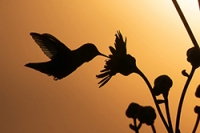Holding both a degree in Art and Wildlife Ecology, I work to combine my two passions through wildlife and nature photography. The photographic platform allows me to take my experiences and understanding of animals to a different level, giving me the ability to introduce others to the way wildlife live and exist in our world today.
- Charlotte R. Catalano
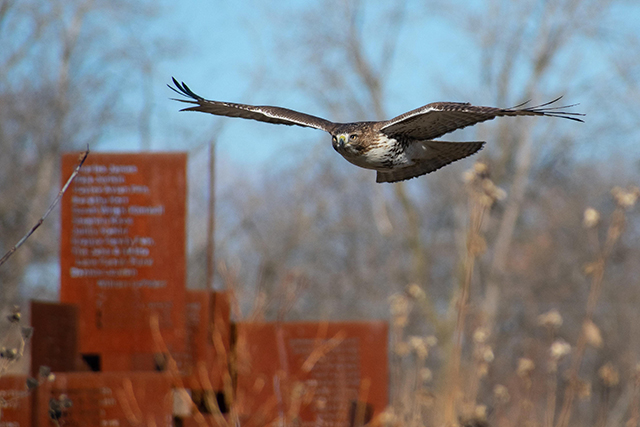
An immature red-tailed hawk (Buteo jamaicensis) taking off in search of its next meal in December 2018.
Not too long after the bird took off, s/he returned and briefly perched atop the arboretum rock arch at Riverside Park in Milwaukee before diving straight down into the tall grass, popping back up a moment later with a rodent in its talons. You might imagine I completely geeked out about witnessing this event.
Factoid: Red-tails prefer natural perches, like trees/snags, but this hawk chose a variation on the theme by choosing a metal tree sculpture instead. Here the raptor can be see flying by the art piece-turned-hunting station in Riverside Park.

I originally aimed to photograph goldfinches in the Riverside Park oak savannah when the hummingbird caught my eye. Associating the fast fliers with red or bell-shaped flowers, I did not expect the bird to repeatedly visit Cup Plant (Silphium perfoliatum), a yellow composite flower. For several evenings, I came to this local, urban park, observing and photographing the hungry birds. My patient efforts paid off when I reviewed my images and found the hummingbird frozen midflight against the evening sky. August 2018.
Factoid: During the day hummingbirds need to drink every 15 minutes in order to stay alive and healthy. However, at night, the birds practice torpor (think hibernation), to lower their metabolic rate and consume up to 50% less energy while asleep.
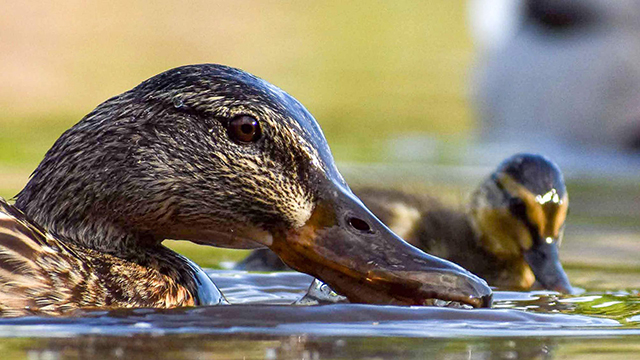
Mother's watchful eye: This mother duck already lost one duckling. Left with only a single baby, she now seemed more intent to safeguard the young one than a day prior when she still had two. Science tells me it is rare for a mallard to rear all her young to maturity, and I recognize I will never know what happened to the lost duckling, nor this pair. After a near week at this newly-constructed ephemeral pond at Riverside Park in Milwaukee, they disappeared. I'd like to imagine a happy ending with the mother and duckling making their way to the river less than 100 meters (200 ft.) away. June 2018.
Factoid: During a ducklings first week, the biggest threats they face include predation and risk of hypothermia.

I'd been chasing urban coyotes (Canis latrans) for several months; I'd tracked them through snow and sat in a blind, culminating in roughly half a dozen distant encounters. However, none of that lead to me getting this shot. Instead, all I did was get out of my car at Riverside Park when s/he walked right past me at the end of the road. I've never been more thankful to have my camera out and ready to go. June 2018.
While this encounter was most likely the closest one I've had with a free-ranging carnivore, the coyote wanted absolutely nothing to do with me or the other couple present (but further away). S/he eyed us warily and did not attempt to approach us Homo sapiens, as is appropriate and good to see, rather s/he continued about her/his business before pulling off an impressive vanishing act, disappearing into the oak woodland.
Factoid: Badgers and coyotes have been documented, in a manner, hunting together. One of the carnivores will pursue a ground squirrel or prairie dog into a burrow while the other predator waits at the "back entrance" to grab the prey that assumes it is in the clear to pop out.
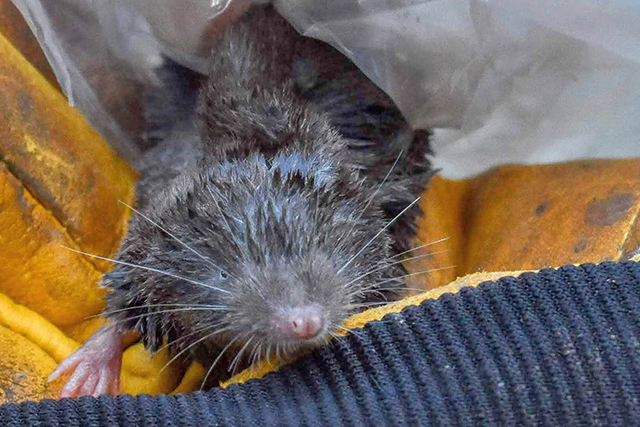
This adorable, little northern short-tailed shrew (Blarina brevicauda) may look larger than life here, but to put it in perspective, the small mammal is being held in a mammalogist's hand! After twelve years of mammal monitoring by the Urban Ecology Center in Milwaukee's urban Riverside Park, this wild animal was documented for the first time in 2017, making an epic return to a park that lamented its absence and cheered its return for the second year in a row after an extended extirpation. July 2018.
Factoid: Shrews are one of a few mammals to have a venomous bite! Living, venomous mammals only exist in three mammalian orders today: Eulipotyphla, Monotremata, and Chiroptera.
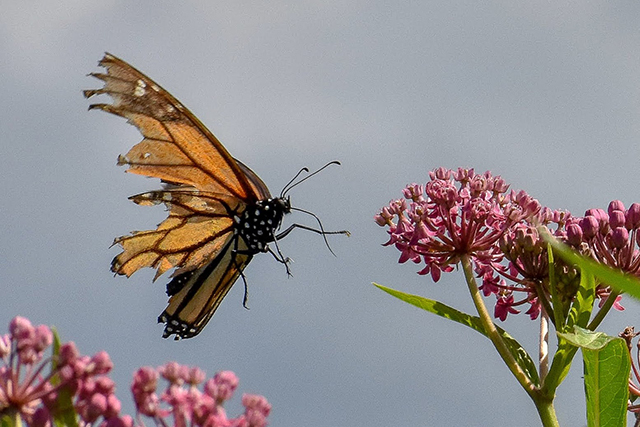
This monarch butterfly was ragged, torn, and scarred, but still soaring. Monarchs ability to persevere in all circumstances is one of the most amazing aspects of the butterfly I have witnessed. Photographing the butterflies has also proven to be an exceptional challenge—they can move remarkably fast and seem unpredictable in their flight maneuvers. I truly respect this hardy butterfly. Riverside Park. August 2017.
Factoid: When weather turns unseasonably cold during migration, monarchs will roost together (sometimes in the hundreds to thousands) on vertical vegetation until the weather turns favorable.

The first time I ever saw a sphinx moth, I was in the Porcupine Mountains in Michigan’s UP, and at the time I never imagined something so outstanding could be found in an urban space. But this hummingbird clearwing (Hemaris thysbe) was busy pollinating marsh phlox (Phlox glaberrima) at Riverside Park, an urban park inside the confines of Milwaukee, WI, a place vastly different from the wilderness of the northwoods. August 2017.
Factoid: Snowberry clearwings will only lay their eggs on certain plants, including species of honeysuckle (Lonicera), snowberry (Symphoricarpos), hawthorns (Crataegus), and cherries or plums (Prunus).
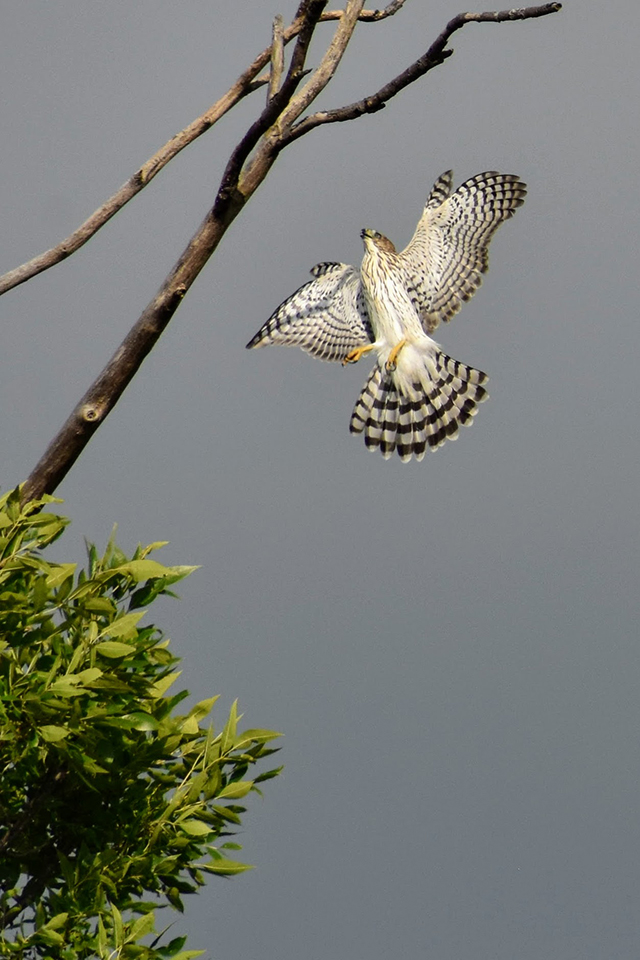
An urban juvenile Cooper’s hawk (Accipiter cooperii) soaring up into a snag as the weather begins to shift. This raptor hatched in Riverside Park in the summer of 2017. The bird, its sibling, and parents were regularly seen actively hunting the park and Milwaukee River after fledging.
August 2017.
Factoid: In the wake of DDT, Cooper’s hawks were a rare sight in Milwaukee alongside many other places in North America. Now, thanks to the banning of DDT, Cooper’s hawk have recovered and are a common sight in all areas of the city and surrounding suburbs.
See more of Charlotte R. Catalano's work
Instagram: https://www.instagram.com/charlottercatalano/
Facebook: https://www.facebook.com/charlottercatalano/
Twitter: https://twitter.com/charlottercat


